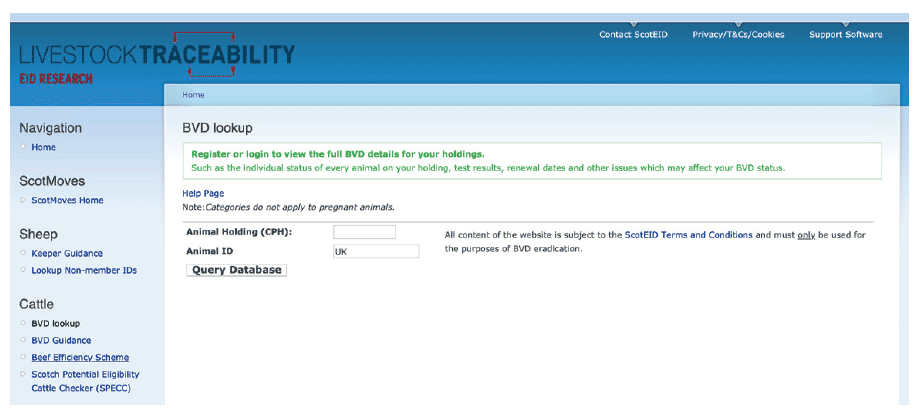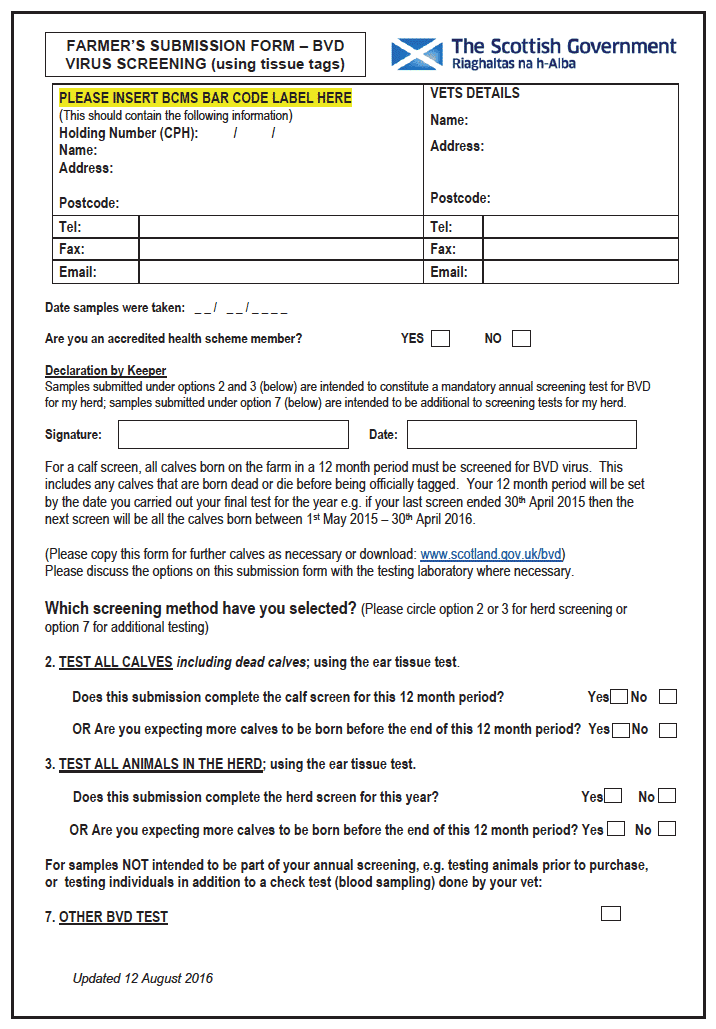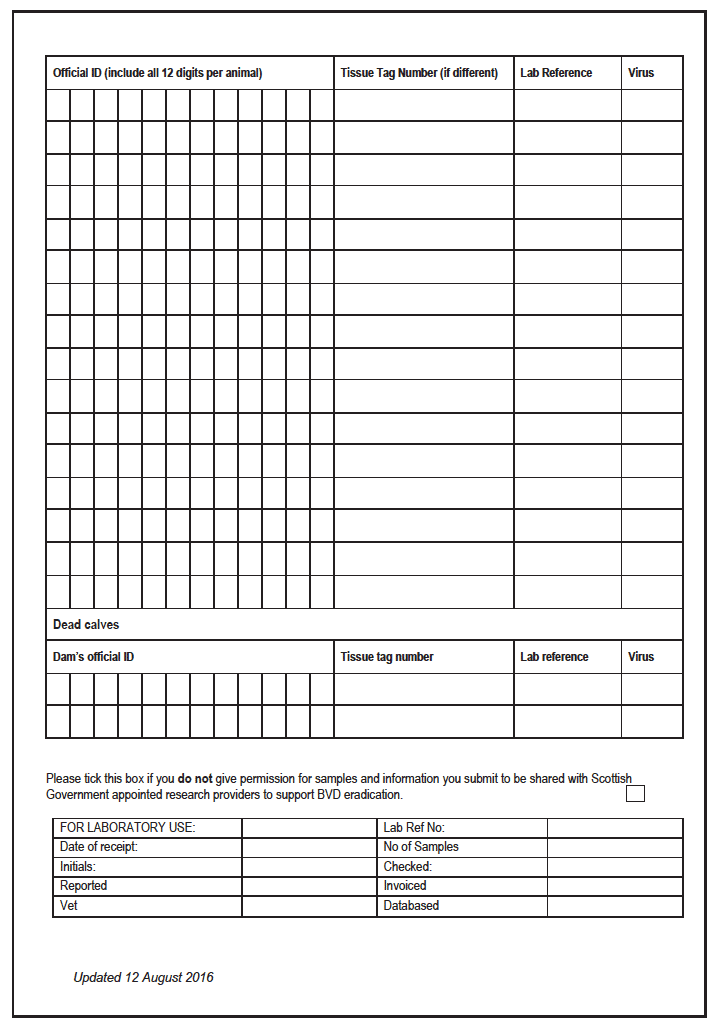BVD eradication scheme phase 5 - December 2019: guidance
Guidance for farm animal vets and cattle keepers on phase 5 of Scotland's BVD (Bovine Viral Diarrhoea) eradication scheme which comes into force on 1 December 2019. This mandatory scheme increases restrictions on cattle herds that have evidence of disease, with the goal of protecting BVD negative herds.
7. Further Information
Terms explained and where to find help and advice
A breeding herd is one in which breeding is expected to take place, or no steps are taken to prevent or minimise the chances of breeding.
A non-breeding herd is one where breeding is not intended.
A PI is an animal that is persistently infected with BVD. These cattle are the main source of BVD infection. In this guidance, we have used PI to refer to any BVD virus positive animal. If an animal has only had one positive virus (antigen) result, there is a small possibility that it was transiently infected at the time of testing and may recover. To be certain it is a PI, arrange for your vet to resample the animal (for BVD antigen) at least three weeks after the first sample was taken. A true PI continues to give positive results throughout its life. A transiently infected animal gives a negative result at the second test and can be returned to the herd.
Trojan cow means a pregnant female with an individual BVD Negative status that is carrying a PI calf. This happens when an unprotected female is infected with BVD in the first 120 days of pregnancy. There is no way to test the unborn calf. The best advice is to individually test the calf for virus (antigen) as soon as possible after birth. Where a pregnant female might have been exposed to infection at the critical time, you should calve her in isolation and BVD test the calf as soon as possible.
Biosecurity
Good biosecurity will help prevent the spread of BVD into your herd. Areas to consider are:
- animals added to your herd, especially pregnant cattle where the BVD status of the unborn calf will be unknown. Make sure you know the herd status of the seller or the individual status of the animal you are bringing in. If in doubt arrange for a virus/antigen test as soon as possible;
- the herd status of the surrounding farms. If in doubt, prevent nose-to-nose contact over boundaries and create a 3 metre double spaced fence to limit exposure to other animals and consider vaccination of the breeding stock;
- the BVD virus can spread through clothing and equipment, maintain good cleaning and disinfection at entry to cattle areas.
Vaccination will not eradicate BVD from your herd but is a useful tool for controlling the disease in different age groups of cattle. Vaccination can protect dams in the early stages of pregnancy, and it is essential that the vaccine is administered at the correct time i.e. before the bull is introduced or before they go to a mart. There are several vaccines available on the market that are very effective, but take care to follow the datasheet instructions precisely. This includes the storage of the vaccine, timing and boosters. You should work with your vet to determine whether vaccinating is a good option for your herd.
Separately Managed groups
The correct identification of each separate group is critical to the effectiveness of check testing. A separate group consists of those animals that can freely achieve nose-to-nose contact with all others within the group; for this reason you may have several separate groups within your holding and you may have to sample more than once per year. Your vet should ensure that an appropriate number of animals has been chosen from each separate group on your holding. Housed animals on either side of a central passageway, for example, are separate groups.
PI animals spread the virus efficiently when in nose-to-nose contact with other cattle. Housing with trough feeding will ensure rapid spread, whereas spread will be slower among cattle at grass. BVD spreads so easily it is not necessary to test every animal in every group. Five animals are sufficient providing the following conditions are met:
- All the animals in the group have been together with close contact for at least two months.
- They have had nose-to-nose contact during that period.
You must consult a vet when identifying the separate groups in your herd and before choosing the animals to be tested.
Imported Animals
Animals bought in from untested, Non-Breeding, BVD Not Negative or BVD Positive herds must be BVD antigen tested with results uploaded to ScotEID within 40 days. Failure to do so results in your herd status being downgraded to BVD Not Negative until the animal has been tested.
Exceptions to this are:
Accredited English animals - If an animal has been born on an English holding, which has been CHeCS accredited for the full lifetime of the animal and has given the health scheme provider permission to publish their status, it will not require testing.
Northern Irish cattle - All cattle with ear tags starting UK9 and born since the start of the NI BVD eradication scheme (1st March 2016), are deemed as low risk for BVD. This means that young stock brought into Scotland from Northern Ireland will not require BVD testing.
For cattle that have been BVD virus tested outwith Scotland by a Scottish Government approved laboratory, it is possible to get these results uploaded to ScotEID.
Sources of advice
The BVD helpline assists with queries about the BVD eradication scheme. The Scottish Government's BVD policy team deal with questions on the policy. Your own vet or lab may advise on how best to eradicate BVD and protect your herd.
BVD Helpline - 0300 244 9823
BVD results and the BVD Herd Status are uploaded to ScotEID by approved laboratories.
BVD Look up
The BVD Look Up on ScotEID is available to all cattle keepers.
Public access allows the look up of a CPH to see the BVD Herd Status. Look up of an ID number will show the individual animal's BVD status.
When logged into ScotEID, a farmer can view all of their own test results, the herd status, individual status and animals that need to be tested for BVD virus.
ScotEID
You can access your own BVD records in detail. Contact the ScotEID helpline if you do not already have access: 0300 244 9823. To ensure that your vet has full access to your BVD testing history, and to help manage your status, make sure your details are correct on all BVD submission forms, including your vet's postcode.
Vet online BVD training is available through SRUC. This CPD course covers specific vet instruction for BVD testing, including vaccination, separately managed groups and other helpful information. Vets must complete the course to sign vet declarations and CBI confirmation certificates. The course is accessed through the Scottish Government website under the Scottish BVD Eradication Scheme www.gov.scot/publications/bovine-viral-diarrhoea-bvd/pages/scottish-bvd-eradication-scheme/
Veterinary declarations
Approved vets can change the status of a herd to BVD Negative if they have sufficient evidence. Vet declaration forms can be requested from ScotEID. To be approved, a vet must complete the online BVD training through SRUC.
Compulsory BVD Investigation Confirmation Certificate
Similar to veterinary declarations but used at the end of the Compulsory BVD Investigation to confirm all animals in the herd are BVD Negative or BVD Assumed Negative. The certificate can only be completed by an approved vet.
The ScotEID website and BVD lookup
The ScotEID website at www.scoteid.com is the central point at which all BVD results, herd status and individual status can be found. All approved laboratories report their results directly to ScotEID.

You can check your herd status at any time by entering your CPH number in the database search box. If you register with ScotEID you will be able to quickly see the BVD results for every test, and the individual status of every animal on your own holding. If you have concerns about your herd status, please contact your vet or laboratory to get this resolved.
The BVD status of any holding or animal can be determined by entering the County Parish Holding (CPH) number or animal ID into the BVD look up page on the ScotEID website. To prevent your herd from becoming infected, the status of every animal should be checked before it is introduced into your herd.
Only animals from a BVD Negative herd, or animals which have an individual Negative or Assumed Negative status, are allowed to move. Do not jeopardise your own status by purchasing animals from a BVD Not Negative herd unless they have been individually tested Negative for BVD virus.
For 'BVD Not Negative' holdings, only those animals which have an individual Negative or Assumed Negative BVD status, may move. For these holdings it is particularly important to check the individual status of each animal. If you notice any discrepancies in the data, please contact the responsible laboratory or the BVD helpline to resolve the issue.
Help on how to use the BVD look up is provided on the website or through the BVD helpline on 0300 244 9823.
BVD Herd Status Table
| Category number/BVD herd status |
Description |
Impact on animal movements to other herds or a livestock market |
|---|---|---|
| Note: Individual animal status will override herd status and should be referred to wherever possible |
||
| 0 Non-breeding |
Keeper is non-breeding (no calves registered in past 12 month) or has declared that the herd is non‑breeding |
None |
| 1 Certified Negative |
The herd is CHeCS accredited as BVD Negative. |
Can move anywhere. Testing is optional. |
| 2 Screened Negative |
The herd is Screened Negative, either by testing all calves, all animals or by check testing young stock. |
Can move anywhere. Testing is optional. |
| 3 Not Negative |
The herd:
|
Cattle that don't have an individual BVD Negative or Assumed Negative status must be tested prior to move. |
| 4 Positive |
Herd includes one or more persistently infected (PI) animals. |
Cattle that don't have an individual BVD Negative or Assumed Negative status must be tested prior to move. |
BVD Individual Status Table
| Category |
BVD status |
Movement restrictions |
Biosecurity recommendations |
|---|---|---|---|
| 1 |
Negative |
None |
Beware Trojan cows (see section 7) Test calves born, conceived prior to arrival |
| 2 |
Negative |
||
| 2 |
Assumed Negative |
||
| 3 |
Not Negative (known as 'risky') |
Must not move to another herd or market if from a Scottish holding. If from a non-Scottish holding it may require BVD testing within 40 days. From Non-Scottish: If an animal has been born on an English holding that has been CHeCS accredited for the full lifetime of the animal, it will not require testing, subject to confirmation by the CHeCS provider. Any animal born in Northern Ireland since 1st March 2016, will not require testing. |
Isolate from breeding stock and individually test |
| 4 |
BVD Positive |
Cannot move to another herd or market. Can only go directly to an abattoir, or under an APHA licence in special circumstances. |
Isolate and retest Move directly to slaughter |
| 0 |
Untested |
None |
Individually test |
Samples and laboratories
Samples are taken by the vet or the keeper and sent to a laboratory approved by the Scottish Government, with the following information:
- BCMS barcode sticker if available
- Keeper's name, address and postcode
- Vet practice name and postcode
- CPH number the animals are registered to
- The CPH number for the holding on which the herd is kept
- The date samples were taken
- Which testing method was chosen
- The full 14 character official ear tag numbers for all the animals which were sampled.
For calf screens, indicate when you have reached the end of calving year so that the laboratory knows when to set the annual herd status, see section 4.
An example form.

If you need more copies of this form, please go to the website at: www.gov.scot/bvd.
You should ensure that the animal ID numbers are correct for the animals you have tested. You can check this on the ScotEID website. Any errors in the animal IDs may prevent you from moving them if the result is not recorded due to an incorrect animal ID.

Laboratories
There are a range of approved laboratories, the details of which can be found at www.gov.scot/bvd. The laboratory to which you submit your samples will inform you and your vet of your results and pass on your herd status to the Scottish Government. In addition, they will report individual results for every animal tested for virus. We will presume all cattle that test positive for antigen (virus) are PI animals, until proven otherwise by a future test. Your tag supplier will state which lab to send your samples to.
Frequently Asked Questions
1. Got BVD? Don't worry, you can just vaccinate.
False - Vaccination does not deal with PI animals. They are too highly infectious and will still be able to spread infection potentially creating yet more PIs.
2. You should keep a PI animal on the farm so that your animals are not naive i.e. the idea of PI parties, 'natural vaccination'.
False - PI animals are highly infectious and should be culled as soon as they are identified. BVD causes significant losses on herds that have it, through transient as well as persistent infection. An animal that is transiently infected will suffer lower immunity and increased susceptibility to other diseases as a result and can reduce fertility.
3. The government is making vaccination compulsory/the government is banning vaccination.
False - Vaccination will continue to be available and is a decision to be taken between keepers and vets.
4. You can't get rid of BVD, because of transient infection.
False - The evidence is overwhelming that removing the persistently infected animals will stop the disease from circulating. Transient infection will fizzle out on its own.
5. There's no point in getting rid of BVD, because my herd will be re-infected by sheep/deer.
False - Sheep can carry BVD and can re-infect your herd, but only if they have been in contact with cattle with BVD in the first place. Removing the source of infection - the PI cattle - will reduce BVD among sheep. Also, transmission from sheep to cattle is very weak, so only a small number will be unlucky enough to get re-infected this way. To be sure though, you should keep breeding cattle away from sheep. Deer can carry BVD, but we have no evidence to suggest this is a serious problem, and again, removing PIs will remove a major source of infection for deer.
6. It's impossible to eradicate BVD from my herd - I've been trying for years.
False - The vast majority who have followed a CHeCS scheme have got rid of BVD in under two years. If you test to find your PIs, slaughter them, buy in only BVD-free cattle or isolate and test them, test your calves for two years, and exercise good biosecurity, you should get rid of a BVD infection in under 24 months. All the studies show that the benefit to your profits will far outweigh the cost of getting rid of BVD.
7. I've got a PI animal, but it looks alright, so I don't need to slaughter it, I'll just finish it.
False - Very few PI animals ever reach a good slaughter weight. You will only waste money trying to feed it. While it's on your farm it is a significant disease risk to the rest of your herd. It's always better to send it for slaughter immediately.
Where can I get more information?
The best source of advice and information is your vet.
If you are in a health scheme you will be able to access specialist advice through them.
For more information on the Scottish BVD eradication scheme, screening requirements and information about ScotEID please go to www.scoteid.com or call the BVD helpline on 0300 244 9823.
If you have any questions specifically relating to BVD policy development, please call the policy team on 0300 244 9877 or email bvd@scotland.gsi.gov.uk.
For more information on BVD in general, visit the Scottish Government's website at www.gov.scot/bvd which explains more about the disease.
Further copies of this guidance are available from:
BVD Policy TeamScottish Government
Animal Health and Welfare Division
Saughton House
Broomhouse Drive
Edinburgh
EH11 3XD
Tel: 0300 244 9877
Fax: 0300 244 9797
Email: bvd@scotland.gsi.gov.uk
Website: www.gov.scot/bvd
BVD Look up: www.scoteid.com
The BVD helpline: Tel: 0300 244 9823
Contact
Email: bvd_consultation@gov.scot
There is a problem
Thanks for your feedback